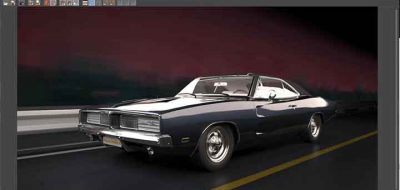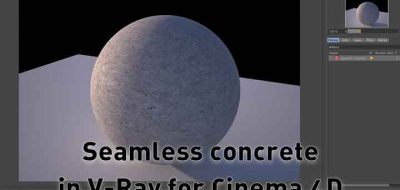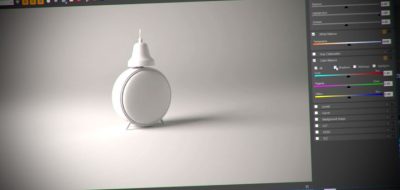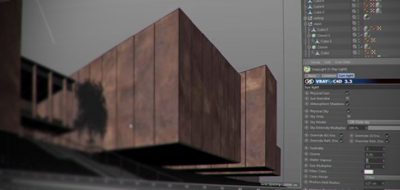If you are a C4D user, you may have felt the frustration of having V-Ray for Cinema 4D feel like it was completely out of your hands. There is a bit of truth to those feelings, with V-Ray being handled by a third party developer specifically for Cinema 4D. In the past, this has made updates to V-Ray for Cinema 4D really fall behind the V-Ray core engine from The Chaos Group.
With no other rendering alternatives in sight, this would have been fine – but with what seems to be an explosion of Cinema 4D users who have adopted Octane, this is detrimental.
VRAYforC4D Parity
Recently however LAUBLab KG, the developers for VRAYforC4D announced that V-Ray in Cinema will use the latest version of the V-Ray core from the Chaos Group. This version will be based on the newest official V-Ray core 3.25 from Chaos Group, and brings with it all the features. LAUBLab calls it “the biggest update for VRAYforC4D since v1.0.”
The numbering version has also changed to better match the release numbers of the V-Ray core. Previous versions of VRAYforC4D were called v1.9 (V-Ray 2.55). The new version will reflect the version number of V-Ray itself with “VRAYforC4D 3.25”.
LAUBLab has also announced an open beta program for all VRAYforC4D users that will start September 2015 with a 3.25 version that runs on MAXON Cinema4d v16 and v17 versions. (final release will run from c4d v15-v17). They also note that you are able to run V-Ray version 2.55 version along side the 3.25 version, having both on your system at one time.
What will be new in VRAYforC4D
LAUBLab also gave an overview of the features that are part of the 3.25 version:
- New great V-Ray 3 render speed. faster ray tracing and render performance; all parts of V-Ray had been greatly optimized using state of the art ray tracing technology. you see the same render speed as in newest V-Ray Max3.25
- New progressive sampler rendering: see your render within seconds instead of waiting for buckets
- Dynamic Bucket splitting
- New default universal render setup for path tracing (BFLC) and IRLC based work, which eliminates the need to set or tune any light or material subdivision, or DMC settings (all done by the V-Ray core). biased and unbiased ray tracing methods for choice.
- Fast IPR window (interactive preview render): based on V-Ray RT v3 (cpu or gpu for choice)
- V-Ray RT production rendering in picture viewer and editor
- RT Lightcache support
- multifacetted GTR BRDF (ggx pro with tail control)
- Min shading rate (can replace subdivision control within one single slider)
- v3 max ray intensity setting (can speed up rendering)
- Lot faster hair, grass & fur rendering
- Lot faster instance and proxy rendering
- Embree 2.3 (also dynamic geometry like displacement ,hair, mb, proxies)
- Probabilistic light sampling:a lot faster rendering with huge number of area lights
- Render masks
- V-Ray Clipper (make easy render time sections of objects or groups of objects)
- Reflection/refraction sets (include /exclude lists)
- New Object based and unbiased/raytraced (still fast) subsurface scattering option in SSS2 mat and channel, RT compatible
- V-Ray Skin material
- V-Ray Volume material
- New static displacement options (faster)
- Udim textures**
- Tiles exr and tiff loading (load /unload buckets of bitmaps on demand to save ram)
- Open exr2
- Separate light select layers for render elements (V-Ray light select)
- Deep image saving
- Sampler-Info-Tex shader as in V-Ray Maya, to read out scene data and use for shading
- OSL shader and OSL material
- New disk area light
- V-Ray frame buffer,with ICC, .OCIO, LUT, .cube, interactive burn,exposure,highlight, color balance controls (for sure in windows, for OSX depends yet on the V-Ray sdk, for OSx it might come in SP)
- Lens effects
- New vrmesh export, with all features, animated vrmeshes, hair and particles in vrmeshes
- Vrscene node (loading external vrscene files on render time)**
- Vray metaball surface,
- Open subdiv support
- Additional vray shaders (vray curvature, vray ray switch, vray user data color, vray user skalar, bercon noise)
- Clip opacity feature for faster cutout alphas
- Optimised volume rendering
- New LC feature for animation
- Support for OpenVDB, Field 3d and Vray Volume grid**
- Improved translucency in 2 sided mat
- New Dr features (add & release nodes while render, exclude local machine from render)
- Cache geometry and textures**
- Quick setup
- Simplified user interface (optional like vray 3 max)
- Faster material & shader preview & GUI
- Support for V-Ray stereo cameras
- Support for 6×1 cubic stereo VR cameras (for Oculus Rift use p.e https://www.oculus.com/en-us/rift/)
- New Spherical Panorama stereo camera
- Support for sub folders in c4d search paths
- Bitmap aperture & optical vignetting in V-Ray physical camera
- Shademap support for stereo images(speeds render up)
- OGl resolution options for bitmaps in editor
- V-Ray presets, V-Ray tool bar
- V-Ray Node based Material editor (in SP)
- MAXON Team Render still image splitting support







Mark
About bloody time, I’ve just bought Maxwell as a prime/supplemental render for quality, simplicity, incredible materials & beautiful renders.
VrayforC4D has required way too much black magic & relentless tests to get the best combo of speed & artefact free animation. (Yes, I ended up using BF for everything needing animation)
So glad VrayforC4D is catching up to its ported siblings; it IS a great renderer.
Mark
Well done Stefan & team, this new version looks amazing.